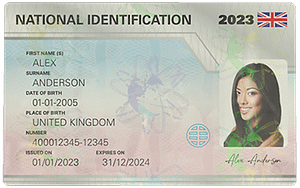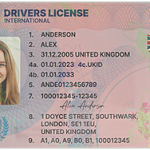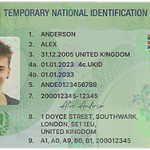Fake ID cards are illegal and unethical items that can cause serious harm to society, individuals, and institutions. However, understanding the trends in their design can help authorities, businesses, and the public be more vigilant and take preventive measures. This article will explore some of the common trends in fake ID card design, although it must be emphasized that the creation, use, or distribution of fake ID cards is a criminal offense.
Material – Mimicking High – Quality Originals
One trend in fake ID card design is the attempt to use materials similar to those of real ID cards. Genuine ID cards often use high – quality plastic with specific thicknesses, textures, and finishes. Counterfeiters are now trying to replicate these aspects. For example, they may source plastics that have a similar feel and appearance to the polycarbonate or PVC used in legitimate government – issued IDs. Some fake IDs even have a laminate layer that mimics the protective coating on real IDs, giving the impression of authenticity at first glance.

To combat this, security personnel and businesses need to be trained to recognize the exact characteristics of the materials used in real IDs. For instance, real ID cards may have a unique sheen or a specific way the plastic bends slightly under pressure, which counterfeit materials may not replicate accurately.
Printing Technology Advancements
With the development of printing technology, fake ID card designers are taking advantage of more advanced printing methods. High – resolution printers are being used to create clearer and more detailed images on fake IDs. This includes sharper photos of the supposed cardholder, as well as more accurate reproduction of text and logos. Some counterfeiters are also using color – matching techniques to make the colors on the fake ID closely resemble those on real ones.
Moreover, the use of special inks is on the rise in fake ID production. Fluorescent inks, for example, can be used to mimic the security features found on real IDs that are only visible under certain lighting conditions. However, real ID cards often use inks with unique chemical compositions that are difficult to replicate. Security experts can use specialized equipment, such as UV lights and ink – analysis tools, to detect the authenticity of the inks used on ID cards.
Emulation of Security Features
Security features are a key element of real ID cards, and fake ID designers are constantly trying to replicate them. Holograms are a common target. Real ID cards may have complex holographic images that are difficult to reproduce. Counterfeiters, however, are attempting to create holograms that look similar, although these are often of lower quality. For example, the depth and clarity of the holographic image on a fake ID may be lacking compared to the real one.
Another security feature being emulated is the microprinting. Microprinting on real IDs contains small text that is difficult to reproduce accurately. Some fake ID designers are trying to print small text, but it often lacks the precision and sharpness of the real thing. Additionally, security threads embedded in the ID card material are also being imitated. Real security threads have specific characteristics, such as being able to conduct electricity in some cases, which fake threads may not possess.
To identify fake IDs based on security features, it is crucial to have access to reference materials that clearly show the correct appearance and functionality of these features on real IDs. Regular training for those who handle ID cards, such as bouncers in clubs, bank tellers, and border control officers, is also essential.
Customization and Tailoring
Fake ID card designers are also offering more customization options. They may be able to create IDs that are tailored to specific regions or countries. For example, a fake ID for use in a particular state in the United States may be designed to match the exact layout, color scheme, and specific features of that state’s real ID. This level of customization makes it more difficult to spot fake IDs at first glance, as they can closely resemble the real thing for a specific jurisdiction.
Moreover, some fake ID designers are catering to the needs of different industries. For instance, a fake ID designed for entry into a bar may have different details emphasized compared to one for use in a casino. This trend requires businesses and authorities to be well – versed in the specific ID requirements and features of their own regions and industries.
Digital Design and Online Distribution
The digital age has also influenced fake ID card design. Counterfeiters are using digital design tools to create more sophisticated ID designs. They can easily modify and adjust designs based on the latest real – ID models. Additionally, the online platform has become a major channel for the distribution of fake ID designs and even the sale of finished fake IDs.
Online marketplaces, especially on the dark web, are rife with sellers offering fake ID cards. These sellers often provide detailed descriptions of the features of their fake IDs, including the supposed level of authenticity. To address this, law enforcement agencies need to constantly monitor and crack down on these illegal online activities. Internet service providers and payment processors also have a role to play in blocking access to such illegal websites and preventing transactions related to fake ID sales.
Common Problems and Solutions
Problem 1: Difficulty in Spotting Low – Quality Fakes
Even with the trends towards more sophisticated fake ID design, there are still many low – quality fakes in circulation. However, untrained individuals may have difficulty distinguishing them from real IDs. For example, a bouncer in a club may be presented with a fake ID that has a poorly printed photo, but without proper training, they may not notice the issue.
Solution: Provide comprehensive training programs for those who handle ID cards. These programs should include visual identification techniques, such as how to look for blurry photos, misaligned text, or incorrect color gradients. Training should also cover hands – on experience with real and sample fake IDs so that trainees can develop a better sense of what to look for.
Problem 2: Inconsistent Security Feature Verification
Security features on ID cards are supposed to be a reliable way to verify authenticity. However, in practice, there may be inconsistent verification. For example, different security personnel may have different levels of knowledge about how to check a particular security feature, such as a hologram. Some may simply glance at it, while others may use specialized tools to examine it more closely.
Solution: Standardize the verification process. Create clear guidelines and procedures for checking each security feature on ID cards. Provide security personnel with the necessary tools, such as UV lights and magnifying glasses, and ensure they are trained on how to use these tools effectively. Regularly update these guidelines as new security features are introduced or as counterfeiters become more sophisticated.
Problem 3: Lack of Awareness of Regional ID Variations
With the trend of customized fake ID designs for specific regions, there is a lack of awareness among some people about the exact features of real ID cards in different areas. For example, a hotel receptionist in one state may not be familiar with the unique design elements of IDs from other states, making it easier for a fake ID to pass through.
Solution: Compile and distribute reference materials that detail the design, security features, and other characteristics of ID cards from different regions. This can be in the form of online databases, printed manuals, or mobile applications. Regularly update these materials as ID designs change over time. Provide training sessions that focus on regional ID variations to ensure that relevant personnel are well – informed.
Problem 4: Online Fake ID Sales Evasion
Despite efforts to crack down on online fake ID sales, counterfeiters are constantly finding ways to evade detection. They may use encrypted communication channels, anonymous payment methods, and constantly change their online platforms. This makes it difficult for law enforcement to shut down these illegal operations.
Solution: Law enforcement agencies need to collaborate more closely with international counterparts, as fake ID sales often have a cross – border nature. Invest in advanced digital forensics and surveillance technologies to track down these illegal activities. Internet companies should also play an active role in monitoring and reporting suspicious online behavior related to fake ID sales. Additionally, educate the public about the dangers of purchasing fake IDs online and the legal consequences, which may reduce the demand for such products.
Problem 5: Over – Reliance on Visual Inspection
Many people rely solely on visual inspection to determine the authenticity of an ID card. While visual inspection is important, it may not be sufficient, especially as fake ID designs become more sophisticated. For example, a fake ID may look perfect at first glance, but a more in – depth check, such as using a card – reading device, may reveal its true nature.
Solution: Encourage a multi – faceted approach to ID verification. In addition to visual inspection, use card – reading devices that can check the magnetic stripe or chip on the ID card for valid data. Cross – reference the information on the ID with relevant databases, if possible. Provide training on how to use these additional verification methods effectively to ensure a more comprehensive and accurate ID check.



